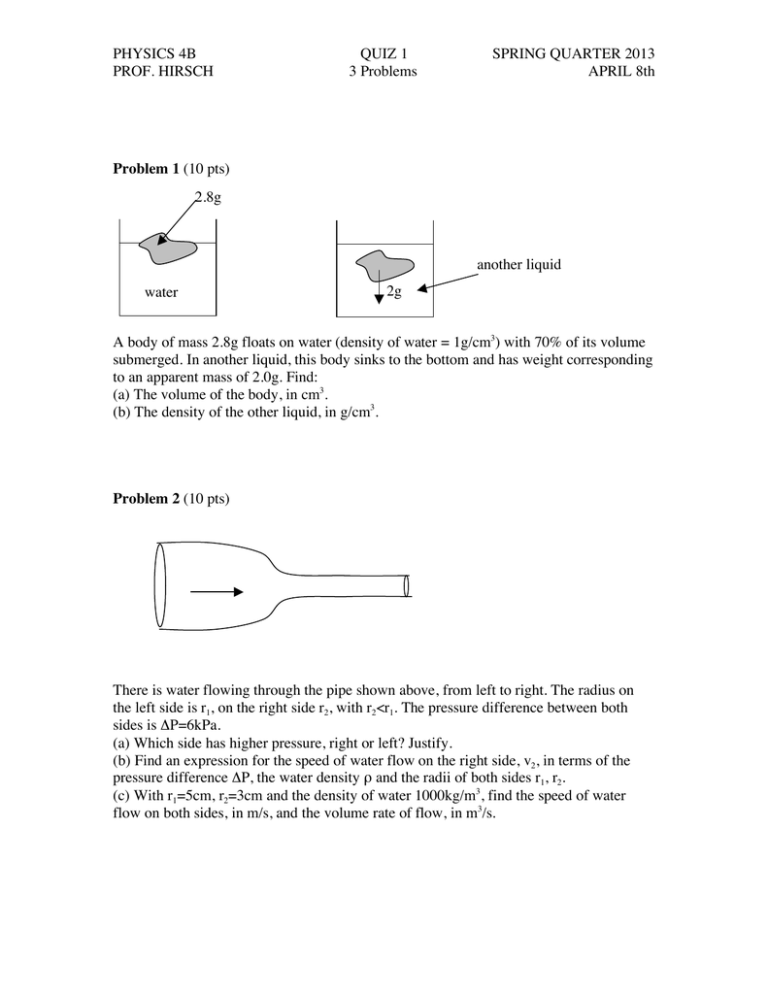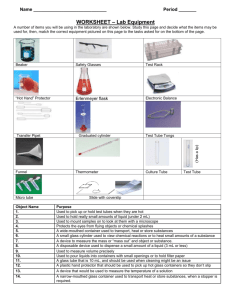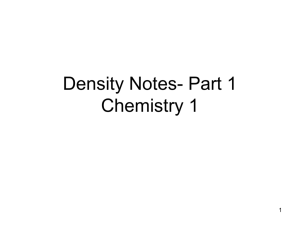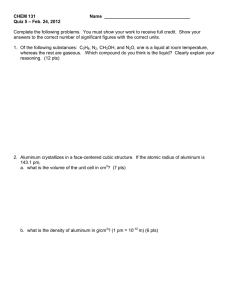PHYSICS 4B QUIZ 1 SPRING QUARTER 2013
advertisement

PHYSICS 4B PROF. HIRSCH QUIZ 1 3 Problems SPRING QUARTER 2013 APRIL 8th Problem 1 (10 pts) 2.8g another liquid water 2g A body of mass 2.8g floats on water (density of water = 1g/cm3) with 70% of its volume submerged. In another liquid, this body sinks to the bottom and has weight corresponding to an apparent mass of 2.0g. Find: (a) The volume of the body, in cm3. (b) The density of the other liquid, in g/cm3. Problem 2 (10 pts) There is water flowing through the pipe shown above, from left to right. The radius on the left side is r1, on the right side r2, with r2<r1. The pressure difference between both sides is ΔP=6kPa. (a) Which side has higher pressure, right or left? Justify. (b) Find an expression for the speed of water flow on the right side, v2, in terms of the pressure difference ΔP, the water density ρ and the radii of both sides r1, r2. (c) With r1=5cm, r2=3cm and the density of water 1000kg/m3, find the speed of water flow on both sides, in m/s, and the volume rate of flow, in m3/s. PHYSICS 4B PROF. HIRSCH QUIZ 1 3 Problems SPRING QUARTER 2013 APRIL 8th Problem 3 (10 pts + 5 pts extra credit) glass tube vacuum h P0 50kg Hg 50kg piston Hg container The container shown in the figure is filled with mercury (Hg), of density 13.6g/cm3=13,600kg/m3, and there is a weightless piston resting on its surface that can move freely, that has on top of it two weights of mass 50kg each. The container has cross-sectional area 100cm2. The inverted glass tube has its open end inside the container, and is filled with Hg up to height h above the surface of Hg in the container. On the top part of the glass tube there is vacuum. The cross section of the glass tube is 1cm2. Atmospheric pressure is P0=1atm=1.013x105N/m2. (a) What is the height h of the column of Hg in the glass tube, in cm? Hint: it is not 76cm. Suppose now one of the 50kg weights is removed, the other one remains: (b) What is the new height of the Hg column, in cm? (c) By how much (in cm) did the piston move up when the 50kg weight was removed? (d) What is the work (in Joules) that was done to move the piston up when the weight was removed? (e) Explain where the energy to do the work calculated in (d) came from. Make a semiquantitative estimate of the energies involved to verify that your explanation makes sense.





